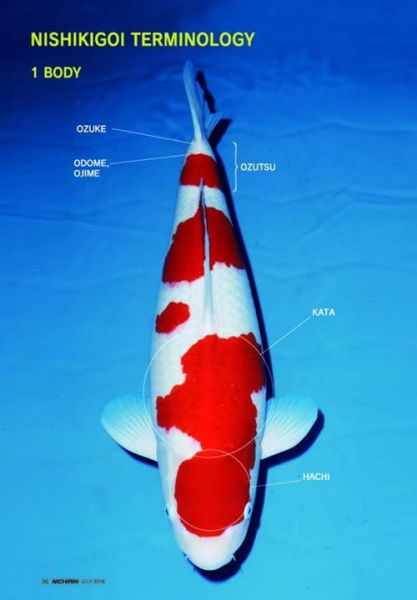They
say "Keeping Nishikigoi begins with Kohaku and ends with Kohaku", means
that everybody is charmed by the Kohaku at the beginning of koi
keeping, then gets distracted by other varieties later on, in the end,
returns to the attractiveness of the Kohaku ( source: Modern Nishikigoi by Takeo Kuraki ).
<Banyak
orang mengatakan bahwa memelihara koi dimulai dengan ketertarikan
seseorang akan attractiveness Kohaku, kemudian mulai tertarik dengan
jenis-jenis lainnya dan ujung-ujungnya/akhirnya kembali tertarik kepada
jenis kohaku lagi>
The
Kohaku is a simple combination of color, that is, koi with red and
white marking. The white color must be as white as snow and the color
combination between white and red, must be contrast reflecting the
combination of Japanese flag. The Kohaku is "The Queen of Nishikigoi".
<Jenis
Kohaku adalah jenis koi yang memiliki kombinasi warna sederhana, yaitu
Merah dan Putih. Warna putihnya usahakan harus seputih salju, sehingga
kombinasi dengan warna merahnya harus terlihat kontras seperti hal nya
warna bendera Japan>
The red color (Hi) of Kohaku can be purplish red and brownish red, 'purplish red' will be getting darker and does not easily fade but somewhat lack of elegance, while 'brownish red'
does not appear very well and fades easily and very hard to keep its
color beautiful, but once the color come out well, the color turn
remarkably fine. It was suggested to choose Kohaku with brownish red.
There are some basic criteria in choosing your Kohaku:
<warna
merahnya bisa warna merah keungu-unguan atau kecoklat-coklatan. Bila
keungu-unguan maka kelak bisa bertambah merah tua dan tidak mudah
memudar, tetapi agak kurang elegan. Sementara, kalau warna merahnya
kecoklat-coklatan penampuilannya tidak terlalu indah dan warna merahnya
mudah memudar dan sangat sulit mempertahankan keindahan warna nya,
tetapi kalau warnanya sampai tampil maka keindahannya akan mengalahkan
yang berwarna keungu-unguan. Disarankan memilih Kohaku yang warna
merahnya kecoklat-coklatan. Beberapa kriteria dalam memilih Kohaku:>
(1) The edge of the red, between red and white, should be clear.
<Batas antara warna merah dan warna putih harus jelas perpindahannya, tidak boleh bergradasi ke dadu-daduan - pinkist>
(2)
The distance between the 'last red' and the 'tail joint' should be 2
centimeter, called "Odome" <tail stop> or "Ojime" <last
red>, if completely red it is called 'Zubon-haki' (trousers) and your
Kohaku look having heavy appearance and disliked.
<warna
merah kearah ekor harus berakhir 2 centimeter sebelum batas body ke
ekor (tail joint), yang disebut dengan istilah Ojime (tail stop). Kalau
warna merahnya nyambung sampai dengan perbatasan body-ekor disebut
Zubon haki (celana panjang) dan Kohaku akan tampil kurang bagus dan
kurang disukai>
(3)
The ideal shape of red color on head area should be 'U shape', where
the mouth area should be white. There are also some basic terms that
hobbyist must understand: (a) "Mekaburi" is a term where the red color
pattern covering all head area and disliked. (b) "Hanatsuki" is a term where the red color spreads down to the lips, without covering the cheeks and jaws, disliked. (c) "Kunchibeni" <lipstick> is small red marking on the mouth area, it is disliked,
especially if Kohaku have large red color on its head area, but it is
still acceptable if the red color on head area does not come down to the
the line of the eyes for merely balancing purpose.
<warna
merah di area kepala idealnya berbentuk huruf U dan disekitar mulut
harus berwarna putih. Beberapa point yang harus teman-teman ketahui: a)
Mekaburi, dimana warna merah menutupi semua permukaan kepalanya,
biasanya tidak disukai. b) Hanatsuki, dimana warna merahnya menyebar
sampai ke pipi samping, juga tidak disukai. c) Kunchibeni (lipstick),
dimana ada warna merah diarea mulut, hal ini juga tidak disukai apalagi
kalau warna merah dibagian kepalanya luas sekali. Tetapi hal ini masih
bisa diterima kalau warna merah dikepalanya jangan sampai batas mata dan
keberadaan kunchibeninya hanya sebagai faktor penyeimbang saja>
(4) The ideal end line of 'red color on the head' is the nose line and at least down to the eyes.
<warna
merah dibagian kepala yang paling ideal adalah sebatas garis hidung dan
setidak-tidaknya sampai dengan batas garis mata>
(5)
The ideal red color pattern should be along the back and be highly
appreciated. If red marking spreading down to the abdominal part called
"Makigafukai" <deep wrapping> and "Makigaokii" <large
wrapping>. Now it is also appreciated, abdomen with some markings
also looks attractive.
<warna
merah yang ideal berada disepanjang punggung. Kalau wrana merah di
badannya turun sampai kebagian perut disebut Makigafukai (bungkus
kedalaman) atau Makigaokii (bungkus keluasan). Sekarang juga diapresiasi
bila dibagian perut terdapat beberapa marking>
The Kohaku, Taisho Sanshoku (commonly called Sanke) and Showa Sanshoku (commonly called Showa) are called the "big three". In the exhibition, these three varieties usually becoming a Champion.
to be continued <koitutor.blogspot.com>


















